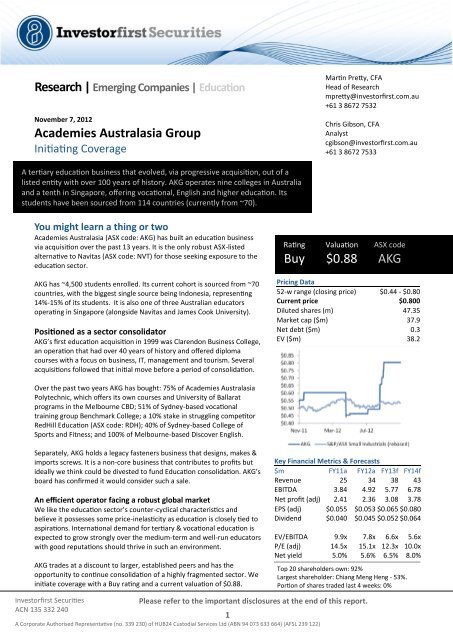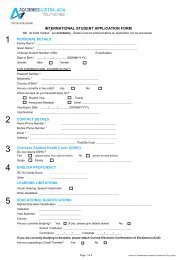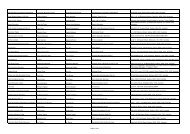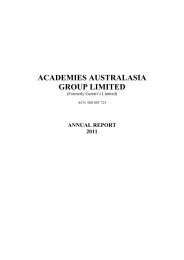2012.11.07 - Investorfirst - Academies Australasia
2012.11.07 - Investorfirst - Academies Australasia
2012.11.07 - Investorfirst - Academies Australasia
- No tags were found...
You also want an ePaper? Increase the reach of your titles
YUMPU automatically turns print PDFs into web optimized ePapers that Google loves.
4novembre 1991 portant réglementation du chômage prévoient également dessanctions pénales pour les mandataires.4.2. En ce qui concerne les différents lieux d’occupation possibles à l’étranger et, sipossible, les données de leur localisationCes données à caractère personnel sont indispensables si un examen doit être réalisé surplace ou si des données à caractère personnel doivent être échangées avec des servicesd’inspection étrangers tel que prévu à l’article 8 de la loi du 16 novembre 1972concernant l'inspection du travail.4.3. En ce qui concerne la période et les conditions de la demande de détachementCes données à caractère personnel sont indispensables si un examen doit être réalisé surplace ou si des données à caractère personnel doivent être échangées avec des servicesd’inspection étrangers tel que prévu à l’article 8 de la loi du 16 novembre 1972concernant l'inspection du travail.4.4. En ce qui concerne les éléments d’identification du travailleur détachéCes données sont indispensables afin de pouvoir établir le lien entre les données àcaractère personnel du fichier GOTOT et les données à caractère personnel enregistréesdans d’autres banques de données à caractère personnel.4.5. En ce qui concerne les données à caractère personnel relatives à la relation de travailCes données sont nécessaires afin de pouvoir vérifier le respect de plusieursdispositions légales ou réglementaires, telles la loi du 3 juillet 1978 relative auxcontrats de travail, la loi-programme du 22 décembre 1989 (titre II, chapitre IV relatifau travail à temps partiel), la loi du 24 décembre 1999 en vue de la promotion del'emploi, la loi de redressement du 22 janvier 1985 contenant des dispositions sociales,la CCT nr. 77bis du 19 décembre 2001 instaurant un système de crédit-temps et l’arrêtéroyal du 25 novembre 1991 portant réglementation du chômage. En effet, lestravailleurs détachés restés liés à leur employeur par un contrat de travail établi selon ledroit belge et restent par conséquent soumis à ces dispositions.B. EXAMEN DE LA DEMANDE5. Il s’agit d’une communication de données à caractère personnel qui, en vertu del’article 15 de la loi du 15 janvier 1990 relative à l’institution et à l’organisation d’uneBanque-carrefour de la sécurité sociale, doit faire l’objet d’une autorisation de principedu Comité sectoriel de la sécurité sociale.6. L’article 4, § 1er, de la loi du 8 décembre 1992 relative à la protection de la vie privée àl'égard des traitements de données à caractère personnel dispose ce qui suit.Les données à caractère personnel doivent être :
RedHill Education (ASX code: RDH)Sydney-based RDH operates three colleges: the Academy of InformationTechnology, Greenwich College (English language) and the InternationalSchool of Colour and Design. It also owns an independent student agencyGoStudy!AKG and associates now own 2.93m shares in RDH, representing a ~10% stake,having progressively purchased shares over the past two years. Thisrepresents a $0.38m investment at the current share price of $0.13.RDH was built through aggregation by private equity investor Exto Partnersand sold to the public in an IPO in 2010, with prospectus forecasts that itnever had any chance of achieving. In April 2012 it announced a restructureunder which its three colleges were brought into a corporate structure, havingpreviously operated semi-autonomously.The company has stated that it is planning to increase its range of courses,implement an online platform, and explore appropriate alliances.Board & managementThere has been significant change on the board with Bruce Baird, JamesHyndes, Benjamin Lunn, Edward Keller and Andrew Leary all departing duringFY12.RDH’s board is chaired by corporate advisor Bill Beerworth, with Exto Partnersdirector William Deane and former Maquarie Graduate School ofManagement lecturer Dr Christopher Clark joining him on the board,alongside CEO Glenn Elith, who was appointed in May 2012.Mr Elith has been appointed as a numbers man—he was RDH’s CFO beforetaking the helm—rather than an education expert. He is a charted accountantexperienced in business transformations and turnarounds, including stintswith Lion Nathan and George Weston Foods. He was CFO at organic retailerMacro Wholefoods Markets, which was sold to Woolworths in 2009.Financial performanceIts revenue line has been stable, generating $14.5m in FY12 and $14m inFY11—but its bottom line has been in the red for the past few years. Aftersignificant pain and restructuring, RDH has reported that it was EBITDApositivein the September quarter of FY13. This translated into positive cashgeneration too.In FY12 RDH had to book a $3m impairment charge for the Creative Designbusiness unit and reverse a previously recognised $1.8m deferred tax asset.This was on top of negative EBITDA of -$1.4m, compared to -$1.1m in FY11.However, operating cash flow was positive, generating $0.4m in FY12 thanksto positive working capital movements. Below the EBITDA line, RDH’s earningshave been further hampered by the amortisation of capitalised Copyrights,which a $1.49m charge in FY12 and a $1.39m charge in FY11.Reported book value at June 30 was $6.7m, including $7.9m in intangibles.Other key shareholders are Redhill Partners (5.1m shares), Regal FundsManagement (3.1m shares) and Welas (1.5m shares).Figure 4: RDH couldn’t meet its targetsRDH prospectus forecastsFY11Revenue $21.4mEBITDA $4.87mNPAT $3.40mEPS $0.126RDH reported outcomeFY11Revenue $14.0mEBITDA -$1.11mNPAT -$1.89mEPS -$0.081Source: CompanyWhat AKG could do with RDH We note that $2.2m of RDH’s coststructure relates to its property &occupancy costs. We’d expect AKG to acton site rationalisation, reducing thatexpense. RDH’s expense on staff was 57% ofrevenue in FY12 compared to AKG’s 21%(which is not directly comparable becauseof Fasteners) or NVT’s 35%. We’d expectAKG would be capable of driving savings.RDH’s market cap is currently $3.8m so AKGcould pay a significant premium and still paya price as a multiple of revenue that issignificantly lower than its own.In fact, RDH’s net cash position at June 30,2012, was $3.2m so after factoring in positivecash flow in the September quarter, themarket cap is close to cash-backing (albeitwith $4m of deferred income to be earned).<strong>Investorfirst</strong> SecuritiesPlease refer to the important disclosures at the end of this report.ACN 135 332 2405A Corporate Authorised Representative (no. 339 230) of HUB24 Custodial Services Ltd (ABN 94 073 633 664) (AFSL 239 122)
Target Markets & Industry BackgroundAKG is predominantly focused on international students (although its 51%-owned Benchmark subsidiary is domestically-oriented), offering bridgingcourses, undergraduate degrees, diplomas, vocational training and Englishlanguage study.Figure 5: Australia’s top industries by GrossValue Added (FY12)Although under-represented in the listed market, education is one ofAustralia’s largest industries, ranking in the top 10 for “Gross Value Added” inthe national accounts.Education has been a key “export” industry, with the historical standards ofAustralian education and its vicinity to Asia making it a popular destination forinternational students. At the peak in 2009 there were just under 500,000international students enrolled in courses in Australia.However, enrolments began to decline post-2009 thanks to four key factors: negative international publicity regarding international student safety; changes to Australia’s migration policies (stronger integrity checks wereintroduced, required available funds for living costs rose 50% to $18k); the collapse of a number of education providers; and the rise of the Australian dollar made other English-speakingdestinations (UK, Canada, NZ, US) more attractive (however we note laterin this report how FX fluctuations between the economies from whichinternational students are drawn have not been as dramatic as AUD/USD).AKG faces a highly fragmented marketWhile universities dominate the Higher Education category (and even thenthere are 135 businesses competing in this category), the key educationalsegments in which AKG competes are highly fragmented.There are currently 4,910 Registered Training Organisations (RTOs), accordingto the Australian Government’s training.gov.au, with another 118 suspendedFigure 6: Historical trend in YTD international student enrolments in AustraliaSource: ABS, <strong>Investorfirst</strong>VET: Vocational Education & TrainingVocational institutions include skill-basedcourses which are closely linked to selectedindustries and give students practical skillsand industry experience. Courses are providedat both government-funded Technical andFurther Education (TAFE) institutes and privateinstitutions. Many vocational instituteshave links and agreements with universities.Through these links, universities may offer upto one year of advanced standing into a Bachelordegree as well as guaranteed entry intoyour course when you achieve the requiredgrades at your vocational institution. Many ofthe courses provide advanced standing intouniversity degrees.Source: IDPSource: Australian Education International, <strong>Investorfirst</strong><strong>Investorfirst</strong> SecuritiesPlease refer to the important disclosures at the end of this report.ACN 135 332 2406A Corporate Authorised Representative (no. 339 230) of HUB24 Custodial Services Ltd (ABN 94 073 633 664) (AFSL 239 122)
Target Markets (cont.)or awaiting re-registration. RTOs are vocational education organisations thatmeet the requirements of the Australian Quality Training Framework. Thefocus of RTOs is on qualifications from Level 1 to Level 4 (these areCertificates, while a diploma is level 5 and a bachelor degree or graduatediploma is Level 8 under the Australian Qualifications Framework).A high level of fragmentation: 135higher education providers, 4,910RTOs & 11,600 providers of othereducation & trainingIn addition, IBIS World estimates that there are over 11,600 businessesoffering Language and other educational services (ranging from businesscolleges to driving schools).At the time of its IPO in December 2004, Navitas (ASX code: NVT) was theleading aggregator of private education institutions in Australia. But now NVThas a $1.5 billion market capitalisation and a global footprint, consolidation ofsmall colleges is unlikely to be its priority (the last small deal it did was the$3.1m purchase of Health Skills Australia in July 2010).We currently consider AKG to be a lead aggregator. We also note offshoreinterest, particularly with US-based and private equity-backed internationalgroup Laureate Education paying $15.5m for a 20% stake in Think: EducationGroup sold by Seek (ASX code: SEK) in August 2012. Laureate was alsoreported as the under-bidder in the 2011 sale of Carrick Institute of Education,which turns over ~$60m a year and was bought by US-based Kaplan.Australian industry in stabilisation modeWe understand the International Education Association of Australia isforecasting a decline in international student numbers to 485,000 in 2013from 499,302 in 2011, with the peak not to be recovered until 2020. Similarly,industry researcher IBISWorld’s projection for the overall Higher Educationsector is that revenue will decline in FY13 (from total revenue of $26 billionincluding a $4.1 billion contribution from international students).NVT described FY12 as the “toughest year” in its history. But it reported thatenrolments for Semester 2 of CY2012 (the mid-year semester) had shownstabilisation, with a 2% increase on the previous year. It was optimistic on theoutlook for FY13, indicating new enrolments of international students to itsAustralian colleges were “showing good growth for the upcoming 201203 and201301 semesters… there are emerging trends of improving demand whichshould reflect positively in FY13 and beyond”.A healthy level of offshore M&AinterestSigns of industry stabilisation inCY2012Knight ReviewMichael Knight was commissioned to review the student visa program in 2010and delivered a report in March 2011. We see the proposed reforms as theinitiation of a “shake-out” in the sector that will advantage credible players,particularly the universities and professional groups like AKG.Knight recommended streamlined processing arrangements for highereducation, vocational education & training (VET) and, where packaged with auniversity course, English language training (ELICOS). The report alsorecommended graduates be entitled to work in Australia for two years,gaining practical experience; and that the ability to speak English cease to be apre-requisite for those seeking to learn English. Most of theserecommendations were accepted by the government, with implementationoccurring in two stages (November 2011 and March 2012).We view Knight reforms a “shakeout” advantaging credible playerslike AKG<strong>Investorfirst</strong> SecuritiesPlease refer to the important disclosures at the end of this report.ACN 135 332 2407A Corporate Authorised Representative (no. 339 230) of HUB24 Custodial Services Ltd (ABN 94 073 633 664) (AFSL 239 122)
Target Markets (cont.)Currency issue overplayedWe don’t believe currency fluctuations are a major factor in demand forAustralian education. Figure 7 (below) shows that currency baskets weightedby origin of international students have not had the same shift as the AUD/USD. The currencies of the nations where international students are comingfrom are quite often more correlated with our the AUD than the USD.For Figure 7, we have detailed industry-wide data and separately we haveestimated AKG’s weightings based on our knowledge that it has a lesserweighting to China and a greater weighting to Indonesia and Brazil than theoverall industry. Overall these estimates equate to a ~2% change for AKG’sweighting and a –4.5% change for the industry since October 2007.We believe demand for education issomewhat inelastic as it is closelytied to aspirationsFigure 7: Student origin-weighted index for changes in AUD with Oct 2007 baseInternational students are generallynot swapping from currencies tied tothe US dollarWhat international students in Aus. think(survey of 8,722 English language students in2011)Source: Capital IQ, Oanda.com, AEI, <strong>Investorfirst</strong> estimatesEducation tied to aspirationWe believe demand for education is relatively price “inelastic”. The middleclassand upper middle-class families in Asia and other developing regionswant a high quality education and employment opportunities for theirchildren. A course fee increase in local currency is not the overwhelmingdetermining factor. Australia continues to attract international studentsbecause it has a reputation for a high standard of education, a favourableclimate and a Western, English-speaking society.A recent survey by leading education agent IDP Education concluded that theprimary drivers for students in choosing their destination country are qualityof education and international recognition of qualifications. It reported thatAustralia “leads on graduate employment opportunities and is also perceivedas safe”, while the USA and UK are perceived to have the highest quality ofeducation and Canada the most affordable (and most favourable in terms ofvisa policies). 83% only applied in Australia 39% chose Australia for native English 25% for further education after English 52% were influenced by an agent inselecting their school 45% were influenced by friends orprevious studentsSource: “English Language Barometer 2011”,International Graduate Insight GroupStudent choices are driven by qualityand recognition<strong>Investorfirst</strong> SecuritiesPlease refer to the important disclosures at the end of this report.ACN 135 332 2408A Corporate Authorised Representative (no. 339 230) of HUB24 Custodial Services Ltd (ABN 94 073 633 664) (AFSL 239 122)
Target Markets (cont.)Furthermore, an annual study by ICEF Monitor of international educationagents continues to find that Australia is considered: (a) one of the five mostattractive study destinations; and (b) the study destination with the equallowest portion of agents considering it unattractive (3%). This survey of 1,023agents from 107 nationalities is set out below.We note that the percentage of agents ranking Australia as “Very attractive”has recovered almost all the ground lost in 2009 and 2010. Importantly for thelikes of AKG, Australia is perceived to be the best in terms of vocationaleducation.Australia is one of the mostattractive study destinations fromthe agents’ point of viewFigure 8: Agents’ view of most attractive countries for study abroadSource: ICEF i-graduate Agent Barometer 2012More broadly, 80% of agents expect the undergraduate and graduate marketsto grow further in 2013.Opportunities to increase domestic student businessAKG’s primary exposure to domestic students is through its Benchmarksubsidiary. There is an emerging opportunity for educators like AKG to play inthe domestic student market thanks to a move to contestability for vocationaltraining. New South Wales has recently announced that from 2014 studentswill be able to choose government-subsidised courses through either thegovernment-managed TAFE system or from private operators, ending a TAFEstrangle-hold. Victoria moved in this direction in 2009, resulting in TAFE’sshare of publicly-funded students reportedly falling to 45% from 66%.Government-subsidised vocationalmarket to open up in NSW to privateeducators from 2014, followingVictorian lead<strong>Investorfirst</strong> SecuritiesPlease refer to the important disclosures at the end of this report.ACN 135 332 2409A Corporate Authorised Representative (no. 339 230) of HUB24 Custodial Services Ltd (ABN 94 073 633 664) (AFSL 239 122)
Target Markets (cont.)Tertiary student volumes to scale up globallyOn current trends, the world is looking at a shortfall of 38m to 40m tertiaryeducatedworkers by 2020, according to a McKinsey Global Institute study,equating to 13% of the demand for such workers. It projects a 31% rise inworkers with tertiary education by 2030 in advanced economies, while inChina it sees the number multiplying 2.5 times.Demand for tertiary education to risesignificantly over next 20 yearsThis means that in addition to the usual incentive for those in the middle-andupperclasses of developing regions to seek further education, corporate andgovernment programs will likely encourage broader demographics.While in aggregate this should mean greater global demand for tertiaryeducation, it does not mean that the current industry structure will remain inplace. Asia, for example, is likely to bolster is domestic educational capacity,while online communication will widen the options available to students.McKinsey cites the case of Germany, where vocational training is conductedjointly by vocational schools and educational institutions, with studentssplitting their time between the two.Figure 9: Projected shift in number of workers with tertiary educationAdvancedeconomiesChinaSource: McKinsey Global InstituteFastenersPremier Fasteners is a small player in a fragmented industry. The “Nut, Bolt,Screw and Rivet Manufacturing” industry has annual revenue of $535m a year,according to IBIS World, and has shrunk at an annual rate of -3.8% over thepast five years. The largest players are Ajax Engineered Fasteners (formerlypart of Austrim Nylex), Bremick (~$491m total revenue according to CapitalIQ) and Australian subsidiaries of Illinois Tool Works (eg Ramset).It is an industry facing pressure from large-scale, low-cost offshoremanufacturers. As such, Premier has been positioned as a niche maker ofspecialised fasteners or fasteners that are needed quickly.Fasteners—must be niche to surviveSimilarly, the end-customers have tended to be manufacturing industries thathave been struggling to compete with imports: automotive, industrialmachinery, furniture and construction.<strong>Investorfirst</strong> SecuritiesPlease refer to the important disclosures at the end of this report.ACN 135 332 24010A Corporate Authorised Representative (no. 339 230) of HUB24 Custodial Services Ltd (ABN 94 073 633 664) (AFSL 239 122)
Historical FinancialsAnnual revenue has grown at a compound rate of 22% a year between FY05and FY12 to $33.9m. Net profit has grown to $2.5m in FY12 from a $2m loss inFY05. EPS has grown to $0.05 in FY12, with dilution due to scrip-payments foracquisitions causing a decline from the peak of $0.06 in FY11.Growth has occurred progressively, although FY08 reported earnings distortthe trend shown in Figure 10 (below), as they included $3.6m in one-off gains.Back in 2005 the Education segment represented just 26% of revenue andcontributed a loss to the group. The following year it broke even. Since then itscontribution to revenue has advanced progressively to 77% in FY12 while itscontribution to pre-tax earnings rose to 89%.Annual revenue has grown 22% ayear since FY05 while EPS hasemerged from losses pre-FY07 to$0.05 in FY12Fasteners has been slow-but-steady at the top-line. Annual revenue for thissegment has grown 22% over the full five years to $7.7m from $6.3m in FY05.But pre-tax profitability has been more volatile, contributing $0.6m to FY12,after peaking at $1.2m in FY10, compared to $0.15m in FY05.Education became a larger pre-tax profit contributor than Fasteners in FY07and a larger revenue contributor in FY08.Cashflow & working capitalOperating cash flow has exceeded net profit in five of the past eight half-years,including four of the past five. In general, as long as student numbers areimproving, AKG should be able to report strong cash flow as it receivespayments in advance for courses—at June 30, 2012 it held $1.5m in advancepayments. However, in 2H12 operating cash flow equated to only 56% ofearnings as tax liabilities were paid down.Our main area of focus in terms of working capital is inventory—which is tiedto the Fasteners segment. Days inventory has risen to ~345 days in 2H12 from261 days in 1H11. Inventory carried on the balance sheet has risen to $3.65mfrom $3.04m over that period. Other than the risk of aged inventory, AKG’sbalance sheet appears strong with net debt of just $0.3m at June 30, 2012.Student prepayments bolstercashflow while there may be room toimprove Fasteners’ inventoryFigure 10: AKG’s historical revenue and earningsRevenueEBITDAFY08 earnings were boosted by a changein accounting ($2.47m) & the write backof future income tax benefits ($1.17m)Net profitSource: Capital IQ<strong>Investorfirst</strong> SecuritiesPlease refer to the important disclosures at the end of this report.ACN 135 332 24011A Corporate Authorised Representative (no. 339 230) of HUB24 Custodial Services Ltd (ABN 94 073 633 664) (AFSL 239 122)
Historical Financials (cont.)EBITDA margins & consolidationSegment data indicates that AKG has run an efficient Education business. ItsEBITDA margins are in-line with those of considerably larger regional peers—around the 20% mark in FY12.Figure 11: Education EBITDA margins (FY11)In fact, AKG achieved a margin just below 25% for this segment in FY11.The healthy margins achieved give us confidence in the company’s ability togenerate value through consolidation, where we expect the smallerbusinesses it acquires will not be as efficient in their processes and structure(and of course will benefit from scale).Source: Company, Capital IQ, <strong>Investorfirst</strong>Earnings ForecastsWe expect AKG to continue to grow the top-line at double-digit rates in FY13and FY14, flowing through to EPS.Key drivers of this growth are: A stronger contribution from 51%-owned Benchmark College in the latterhalf of FY13 on the basis that government spending on training shouldtrend upwards leading into an election year after a pull-back in FY12. A boost from the acquisitions of a stake in Capoeira and the purchase ofDiscover English. The expectation that, in general, the international student market isstabilising and will accommodate mid-single-digit growth in studentnumbers. Ongoing inflation-type growth in tuition fees. Margin expansion in the Education segmentWe assume the Fasteners segment does not expand its earnings, continuing tocontribute
ValuationWe value AKG at $0.88 a share, the mid-point between our DCF and sum-ofthe-partsvaluation estimates. This implies a P/E of 13x, based on our FY13fEPS, which is lower than the average and median of its peers (see Figure 12below).AKG has historically traded at around 9x to 10x trailing earnings, reflecting itsilliquidity and, in our opinion, the lower capitalisation the market would applyto its Fasteners segment, relative to the Education segment.On the basis of our FY13 forecasts, AKG is currently priced on 13x expectedEPS of $0.065.On one hand, that means AKG is priced in-line with the 13x multiple of theS&P/ASX Small Industrials and below the average of 18x that its peer grouptrades on.But on the other hand, AKG is a highly illiquid and tightly-held stock that hasnot traded at all in the past month.Thus we classify AKG essentially as a “private company in a public market”.Our assessment of value, therefore, takes into account a discount for liquiditySum of the partsGiven AKG’s earnings are sourced from two very different businesses, we thinkit is important to assess each on its own merits. As discussed earlier, ideally wewould like to see AKG divest its Fasteners business and reinvest the proceedsin further expanding its Education operations. Our sum-of-the-parts valuationestimate is $0.86—as detailed on the following page.AKG has historically traded on 9-10xtrailing EPS while Education peersaverage 18x consensus forecasts EducationAKG’s most relevant education peers are trading on a median of 17x FY13fconsensus EPS—or 11-13x EV/EBITDA. The smallest and least liquid of itspeers, G8 Education (an ASX-listed childcare business that faces considerablydifferent market opportunities to further education businesses), trades at thelowest end of that range, being 11x.Figure 12: Education peers’ forward multiples (based on consensus)Source: Capital IQ<strong>Investorfirst</strong> SecuritiesPlease refer to the important disclosures at the end of this report.ACN 135 332 24013A Corporate Authorised Representative (no. 339 230) of HUB24 Custodial Services Ltd (ABN 94 073 633 664) (AFSL 239 122)
Valuation (cont.) FastenersIdentifying peers for the Fasteners business is not straight forward. There is noASX-listed peer. In the Building Products segment, GWA Group is priced on aforward PE of 14.5x (in-line with Small Industrials) and an EV/EBITDA of 8.4x.There are some small fasteners businesses listed in Osaka (Japan) but we don’tbelieve their multiples are applicable.There has been some M&A in the sector, although mostly in private marketswith limited disclosure around price and earnings. We do know that StanleyBlack & Decker has been paying 1.6-1.7x revenue for significantly larger andsophisticated fasteners businesses (and in the case of Singapore-basedInfastech it paid 9.1x EBITDA).We expect Fasteners would attractlower earnings multiples thanEducation should the businesses besplitLooking more broadly at ASX-listed industrial & consumer stocks with marketcapitalisations between $20m and $60m, the average trailing EV/EBITDA is7.3x (or 6.6x weighted by market cap). Summing it upWe have used a 6x EV/EBITDA multiple in assessing the value of Fasteners. ForEducation we use 8.7x, reflecting the average of peers less a 10% discount forliquidity. Corporate overheads are calculated on Education’s multiple.Figure 13: Peers’ forward multiples (based on consensus)Source: Capital IQHigher valuation from discounted cash flowOur DCF valuation estimate, using a three-stage model, is higher at $0.90.It assumes: Base cost of equity of 11.8% An additional discount to the valuation of 10% for illiquidity Explicit cash flow forecasts through to FY17, followed by a five-year rampdown to an inflation-type terminal growth rate of 2.5% A peak in EBIT margins in FY15 at 16.7%, followed by a gradual decline to13.6% at the terminal year of FY22Note that under this method cash flows from both segments have beendiscounted at the same rate.<strong>Investorfirst</strong> SecuritiesPlease refer to the important disclosures at the end of this report.ACN 135 332 24014A Corporate Authorised Representative (no. 339 230) of HUB24 Custodial Services Ltd (ABN 94 073 633 664) (AFSL 239 122)
Key RisksReputation & regulationStudents are typically expected to seek out the education provider with thehighest reputation. Indeed, a study by Prospect Research and Marketingsuggested 70% of students were influenced by league tables. Any damagedone to the reputation of a college will, therefore, have an impact onenrolment demand. Adverse publicity surrounding the educational standardsof second-tier tertiary education in Australia, particularly in relation tointernational students, may also become a reputational issue.Government enforcement of education standards also posses a risk to anyeducator that slips in its standards. In October headlines were made in Indiawhen three vocational training colleges were closed for non-compliance withstandards. Colleges that continue to meet the standards must work to ensuresuch news does not tarnish the reputation of the broader industry.Government policyEducation is a highly regulated sector in which government-funding is essential(for domestic students). Educating international students has the added policyoverlay of immigration, making this sector one highly reliant on government.However, AKG has partially countered this risk through its expansion intoSingapore.Offshore & domestic competitionFactors that can impact upon demand from international students forAustralian education include competition from other leading providers ofeducation to international students (e.g. US, Canada and UK); foreign currencyfluctuations and popular trends (i.e. being the “in” country to visit). Onlinecourses from the likes of the University of Phoenix (US) are alsoOnline competition“Massive Open Online Courses” (MOOCs) are offerings of expert tuitiononline. Free MOOCS have been conducted by prestigious universities likeStanford, Harvard and Columbia, not to mention Melbourne. It is feasible thatat some point in the future wealthy students in developing countries will beable to enrol at such prestigious universities and study from their loungerooms. A risk to educators of lower ranking is that an online degree or diplomafrom a prestigious university could be perceived as being better than a realdegree from a 2nd or 3rd-tier educator.LitigationInternational students are reportedly beginning to turn to lawyers when theyfail to get the results they require.Industry changeThere is an argument that the current university model in Australia—anoligopoly of large teaching and research institutions with significant assets—will become unviable in the next 20 years. Ernst & Young has speculated in arecent “University of the future” report that private universities—and possiblypublic universities—will create new products and markets, merging differentparts of the education sector. This could potentially lead to better-resourcedinstitutions competing in the vocational education sector in pursuit of revenuefrom international students.<strong>Investorfirst</strong> SecuritiesPlease refer to the important disclosures at the end of this report.ACN 135 332 24015A Corporate Authorised Representative (no. 339 230) of HUB24 Custodial Services Ltd (ABN 94 073 633 664) (AFSL 239 122)
<strong>Investorfirst</strong> SecuritiesPlease refer to the important disclosures at the end of this report.ACN 135 332 24016A Corporate Authorised Representative (no. 339 230) of HUB24 Custodial Services Ltd (ABN 94 073 633 664) (AFSL 239 122)
Important NoticesThis communication is distributed by <strong>Investorfirst</strong> Securities Ltd (ACN 135 332 240) (<strong>Investorfirst</strong> Securities), which is acorporate authorised representative (No. 339 230) of HUB24 Custodial Services Ltd (ABN 94 073 633 664) (AFSL 239 122).HUB24 Custodial Services Ltd is a participant of ASX Ltd.Disclaimer This communication is not intended to be a sufficient basis for an investment decision. Readers shouldconsult detailed advice before making an investment decision. The information is general information only, it does not takeinto account your particular investment objectives, financial situation or needs. This communication is not an invitation oroffer to buy or sell any securities. Prior to taking any action or making any investment decision, you should consult yourprofessional advisors and consider whether the advice or proposed investment is appropriate in light of your particularinvestment needs, objectives and financial circumstances.Investment involves risk. Past performance is no indication of future results.Although we believe the information is accurate and reliable, <strong>Investorfirst</strong> Securities has not independently verified theinformation, which is provided from public sources, third parties and directors or management of issuers. <strong>Investorfirst</strong>Securities does not represent that the information in this communication is complete, up to date or reliable. Any opinion orforecast or recommendations reflect the information, assumptions and judgment as at the time of writing and may laterchange without notice. <strong>Investorfirst</strong> Securities is not responsible for updating any information, advice or opinion in thiscommunication or for correcting or supplementing any information, advice or opinion in this communication for any error,omission or misstatement which may become apparent after its release.<strong>Investorfirst</strong> Securities, to the extent permitted by law, accepts no liability or responsibility for any direct or indirect loss ordamage caused by any misstatement or error in or omission from this communication or for relying on this communication.Any views expressed in this communication by <strong>Investorfirst</strong> Securities accurately reflect the personal views of the authorabout the subject securities or issuer and may not be the same as the views of <strong>Investorfirst</strong> Securities. No part of thecompensation of the author was, is or will be directly or indirectly related to the inclusion of specific recommendations orviews in this communication. The material in this communication has been prepared by individual people within<strong>Investorfirst</strong> Securities who may from time to time also provide advice to individual or corporate clients.The author principally responsible for this communication receives compensation based in part on revenue of <strong>Investorfirst</strong>Securities and has taken reasonable care to achieve and maintain independence and objectivity in making anyrecommendations.Disclosure <strong>Investorfirst</strong> Securities, its related companies and directors and employees (other than the authors of thiscommunication) might have a relevant interest in some securities mentioned but those holdings are not material unlessdisclosed in this communication. These holdings (or absence of holdings) may change at any time after publication of thiscommunication, without notice.<strong>Investorfirst</strong> Securities, its related companies and employees, directors, consultants of any of them may earn income, fees,brokerage or commissions or other benefits as a result of recommendations, dealing or transactions in the securitiesmentioned in this communication or it may earn referral fees in respect of investors who participate in capital raisings bythe issuers mentioned in this communication. There are no such arrangements currently in place. These interests do notinfluence <strong>Investorfirst</strong> Securities in giving the advice contained in this communication. The directors, employees,consultants or of <strong>Investorfirst</strong> Securities or of its related companies may trade in these financial products in a manner that iscontrary to the recommendations given in this communication or by <strong>Investorfirst</strong> Securities to clients.Confidentiality This information is private and intended only for the particular person to whom it is sent. It remainsconfidential however it is distributed and it and any part of its advice are not to be communicated or disclosed to any otherperson without the written consent of <strong>Investorfirst</strong> Securities.© 2012 <strong>Investorfirst</strong> Securities Ltd
RESEARCH | QUALITATIVEMartin Pretty 03 8672 7532 mpretty@investorfirst.com.auStewart Oldfield 03 8672 7531 soldfield@investorfirst.com.auChris Gibson 03 8672 7533 cgibson@investorfirst.com.auSALES & TRADING MelbourneHugh Robertson 03 8672 7510 hrobertson@investorfirst.com.auBrigid Robertson 03 8672 7509 brobertson@investorfirst.com.auCharles Richardson 03 8672 7507 crichardson@investorfirst.com.auAthol White 03 8672 7511 awhite@investorfirst.com.auMark Kelly 03 8672 7508 mkelly@investorfirst.com.auSydneyPeter Argyrides 02 8274 6075 pargyrides@investorfirst.com.auDrew Metcalfe 02 8274 6096 dmetcalfe@investorfirst.com.auAdam Blumenthal 02 8274 6019 adamblumenthal@investorfirst.com.auPeter Torney 02 8274 6070 ptorney@investorfirst.com.auSteve Moon 02 8274 6044 smoon@investorfirst.com.auKenn MacMillan 02 8274 6043 kmacmillan@investorfirst.com.auQueenslandHaydn Froggatt 07 5520 8788 haydn.froggatt@investorfirst.com.auGeorgia Harrison 07 5520 8788 georgia.harrison@investorfirst.com.auMelbourneLevel 2955 Collins StreetMelbourne, VictoriaFax: 03 8672 7556SydneyPO Box R251Royal ExchangeNSW 1225Level 45Governor Phillip Tower1 Farrer PlaceSydney NSW 2000Fax: 02 9247 6428QueenslandGround Floor, 11 West StreetBurleigh Heads QLD 4220Phone: +61 7 5520 8788SALES SUPPORTShea O’Grady 03 8672 7505 sogrady@investorfirst.com.auFiona Slocombe 03 8672 7506 fslocombe@investorfirst.com.auToll free: 1300 425 892www.investorfirst.com.auCORPORATE FINANCEMatthew Baxter 03 8672 7558 mbaxter@investorfirst.com.auResearch Ratings MethodologySell: Valuation < (Share Price X 0.9)Hold: Valuation > (Share Price X 0.9) < SharePriceBuy: Valuation > Share PriceSpeculative (in addition to Buy/Hold/Sell): nohistory of positive earnings or cash flow; or highlygeared; or highly volatile & inherently uncertainFinancial Risk MetricsGeneral Z-Score: indicator of risk of bankruptcy 2.6: may be in good financial shapeBeneish M-Score: indicator of potential earnings manipulation.A result below –2.22 indicates no apparent manipulationof financial results










